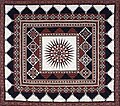
A Hawaiian quilt is a distinctive quilting style of the Hawaiian Islands that uses large radially symmetric applique patterns. Motifs often work stylized botanical designs in bold colors on a white background.
Contents
Hawaiian quilt appliqué is made from a single cut on folded fabric. Quilting stitches normally follow the contours of the appliqué design.




